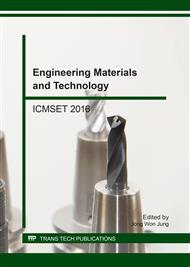p.162
p.168
p.174
p.179
p.184
p.192
p.198
p.209
p.214
Influence of Aluminum Nanoparticles Additives on Tribological Properties of Base Oil
Abstract:
This study investigates the influence of aluminum nanoparticles, oleic acid as dispersants, and rotational speed on the tribological behavior of a lubricant. The experiments are performed on a pin-on-disc tribotester at a normal force of 90 N and a rotational speed ranging from 150 rpm to 600 rpm. Both the aluminum nanoparticles and oleic acid are in concentrations from 0 to 1 wt% and are added to the SN150 base oil. The results revealed that the addition of aluminum nanoparticles and oleic acid to the base oil will lead to significant friction reduction and anti-wear properties. The coefficient of friction (COF) and wear rate decreased after an increase in the concentration of nanoparticles and oleic acid, and an optimum concentration level was exhibited in which both COF and wear-rate were lowest. The viscosity and temperature of the lubricant are also evaluated. Further, the topography of discs after performance of sliding test have been analyzed through the use of an optical microscope, a scanning electron microscope (SEM), and an energy dispersive spectrometer (EDS) in order to interpret the mechanisms of nanoparticle action used to prevent friction and subsequent wear.
Info:
Periodical:
Pages:
184-191
Citation:
Online since:
June 2017
Authors:
Keywords:
Price:
Сopyright:
© 2017 Trans Tech Publications Ltd. All Rights Reserved
Share:
Citation:


